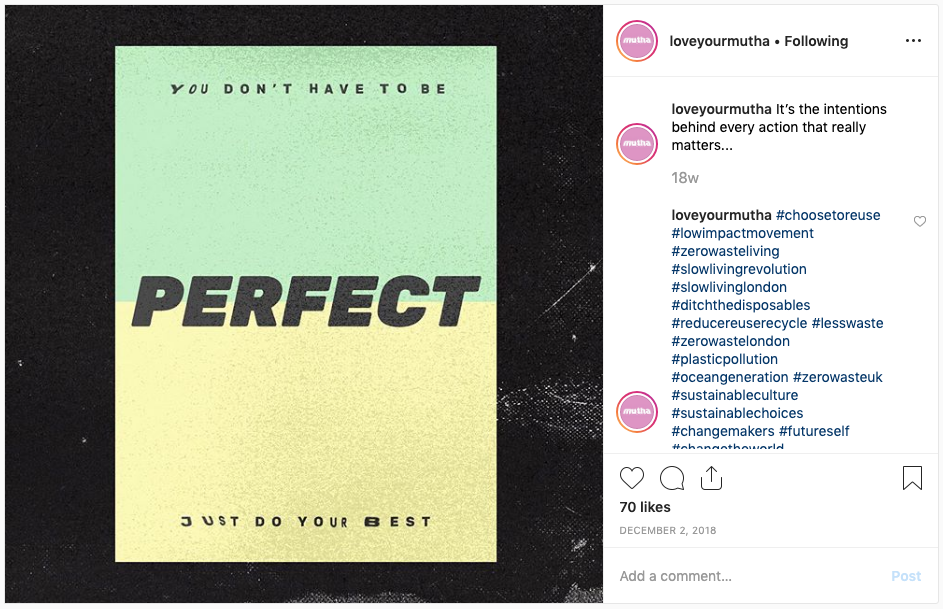Covid-19 was not going to come in the way of Fashion Open Studio 2020 and its audience. If anything, the pandemic gave this year’s designers a greater audience than ever. The studio tours, workshops and conversations were pivoted to a digital format, allowing us to #StayHome while also staying connected with the creative community making use of this time to rethink systems, supply chains and resources.
Sustainability means many things
We celebrated the work of 53 designers across 14 countries including Iran, New Zealand, Vietnam, Nigeria, Zimbabwe, Switzerland and Germany. There was so much to learn from the designers who took part, each one with solutions to the challenges most pressing to them. At Fashion Open Studio we understand that sustainability means many things (and sometimes, nothing at all). Every designer taking part in this programme is finding solutions that will help to move their own business forward without over stretching the planet’s resources and with respect for artisans and garment workers who craft and stitch their collections. The purpose of Fashion Open Studio is to share these stories and help them to reach the audiences they deserve.
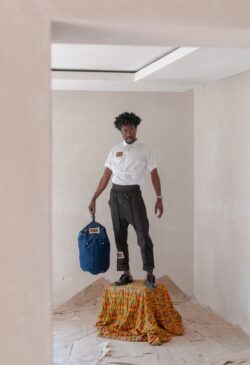
From Fashion Revolution’s incredible global network there were so many eloquent voices, with as many different perspectives on how clothing should be made and valued. From Zimbabwe, Fashion Revolution’s country coordinator Rudo Nondo talked to Julian Tamuka about his brand Guyllelujah. Julian had previously not considered ideas about sustainability until he was introduced to Fashion Revolution through Fashion Open Studio and realised his use of limited resources – deadstock materials and off cuts – and his philosophy of making staple items of clothing because as he says “it’s a staple for a reason, it’s more likely to be of value and stick around longer,” is the way he works out of necessity.
I recommend everyone watches his short video, The New Philosophy of Fashion as there is so much to learn from his approach.
Likewise, from Harare, Haus of Stone presented Therapy of Fashion, which combined mediation and making one session of mindfulness and creativity. The brand’s founder, Danayi, led us through a fusion of yoga; traditional mbira music and hand sewing. Participants are invited to send the roses they make in the workshop to become part of a collective scarf called ‘Hope’.
View this post on Instagram
In Switzerland in collaboration with Mode Suisse, Rafael Kouto asked “What is Upcycling? And what is waste?” Rafael showed how to ‘pimp’ your garments with an introduction on his upcycling practice and so much information and advice on rethinking and valuing the contents of your own wardrobe. It’s a really wonderful and informative session.
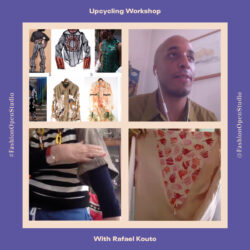
From Pune in India, Karishma Shahani Khan invited small groups into a virtual studio each day to learn quilting, embroidery and hand sewing techniques in a series of sewing circles with the team from Ka Sha and the artisans they work with. They wanted to share the inherent social setting of storytelling and conversations that they witness within their everyday working environment with guests.
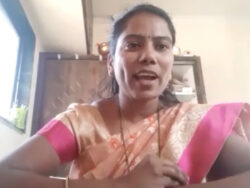
Also in India, in Jaipura in Rajasthan, Iro-Iro showed their practice around implementing zero-waste for their MoonWash collection, focusing on New Heroes with illustrations and readings celebrating women throughout history who have been independent thinkers and doers.
If you missed these remarkable stories, they are still available as a series of readings of letters to women from Cleopatra to the spy princess Noor Inayat Khan, and there is a collection of clothes inspired by each of them.
Vietnamese brand Tamay & Me introduced Mien artisan and co-founder Tamay from Ta Phin village in Sapa,
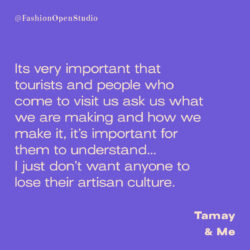
with a special film screening followed by a Q&A with her co-founder Hannah Cowie to explain how they work together and the heritage of the unique craftsmanship that goes into every garment.
Creativity in lockdown thrived
While the world was in lockdown, many designers still had access to their studios, either because they live in the same space, or because they were using them to continue working at a safe social distance in the essential work of making PPE and hospital scrubs as many of the Fashion Open Studio network were doing. Phoebe English talked to us from her Deptford Creek studio in south London, explaining how to quilt with waste using her paper templates.
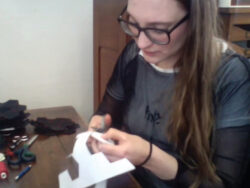
As she spoke, the scrubs she had been making were being counted and packed up ready to be delivered to hospitals in need as part of the Emergency Designer Network with fellow FOS designer Bethany Williams. Elliss Solomon, founder of Elliss, took time out from her work for Scrub Up for the NHS to talk us through her workshop on collage – a key part of her creative development when she is designing a collection. Many others taking part in the week were playing their part in making masks, scrubs and PPE and of course, the week’s events were a great way for people to spread the word, stay connected, and share the challenges of trying to keep business going.
Collaboration makes sense
While there are designers who are still fledgling brands, this is a particularly difficult time for those newly graduated. Among the thousands of fashion graduates unable to even show their final collections as part of a degree show, we showcased the work of two emerging talents who had shown their collections as part of the Central Saint Martins MA show in March, just a week before the lockdown. The portfolio visits traditionally held for industry experts to head hunt talent, were cancelled, with future job prospects on hold for many. Matthew Needham, who temporarily joined the Fashion Revolution team for the week to help on production and Zoom management, talked us through his final collection ØYEBLIKK / 2020 ‘IN THE BLINK OF AN EYE’.
View this post on Instagram
While Needham is an advocate of waste management – a master of using trash as a precious resource in his collections – he is also becoming expert in collaboration, and is sure that this is the way forward. For his session, he brought together his co-collaborators Sneaker artist Helen Kirkum, Biotech materials researcher Alice Potts and experimental milliner Jo Miller. Together they explained some of their processes and how working collectively is a great way to consolidate sustainable thinking, encourage innovation and help lift each other’s practice and find new audiences.
Somerset House x Young Creatives
Fellow CSM MA graduate Paolo Carzana moved back to his hometown in Cardiff, Wales, the week he was supposed to be showing his final collection to the world. Paolo was chosen as the finale to the degree show, with The Boy Who Came Back to Life, a collection packed with details, extraordinary materials, botanical dyes, Pinatex textiles, and layers of story-telling, autobiographical notes, and months’ worth of research.
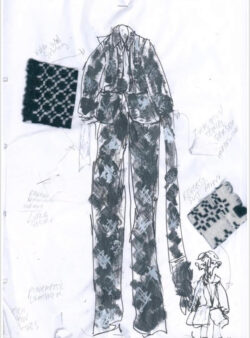
For his session which was part of the afternoon of events in partnership with Somerset House and its Young Creatives programme, Carzana talked from the balcony of his flat overlooking the Cardiff stadium which was at the time, being turned into a Nightingale hospital. He had made a special film, A Self Isolation Waltz for the event showing his collection against the backdrop of the building site below, and talked through his sketches, fabric swatches and references. He also talked about his plans to make a capsule collection for the planned digital London Fashion Week in June, re-using pieces from his previous work. The pandemic has forced him to rethink how he is going to work and sell – and be even more resourceful creative and sustainable as a business going forward.
Also taking part in the Somerset House programme were Bethany Williams, Katie Jones and Congregation Design. Bethany was part of a week-long series of events to celebrate the anniversary of Earth Day, planned with Somerset House long before the pandemic took hold. You can watch highlights of the day here.
There is so much to learn from the 2020 Fashion Open Studio designers. We are still absorbing and catching up with so many incredible and diverse sessions. The digital programme allowed these small, intimate studio conversations and workshops to be viewed by a global audience creating conversations that reverberated between designers and communities that hadn’t previously connected.
We are starting to plan for Fashion Open Studio 2021 and will be announcing how to apply to take part in the coming months. Until then, do spend some time watching the videos on our YouTube playlist and share the knowledge and the work of these change maker designers far and wide.
To stay up to date with Fashion Open Studio, subscribe to the Fashion Revolution youtube channel and follow Fashion Open Studio on instagram, twitter and facebook.
This month’s Power of Influence takes us in a bit of a different direction. On a 15 minute walk from London Euston to London Kings Cross, Fashion Revolution co-founder Orsola de Castro and renowned fashion critic and columnist Sarah Mower spoke with Sara Arnold of Extinction Rebellion (and Higher Studio) about the recent protests, the aim of the movement and the next steps in their fight for climate justice. Shortly after this interview, the UK Parliament declared a climate change emergency.
A little bit of context: On Saturday April 27th, during Fashion Revolution Week and towards the end of Extinction Rebellion’s 2 week occupation of Central London, Slow Factory hosted “Study Hall: Sustainability as a Culture”. The event (in its first international edition) was held in London, UK. Before the event, the Fashion Revolution team along with Sara Arnold, Sarah Mower, speakers, attendees and supporters took a walk to discuss the current happenings.
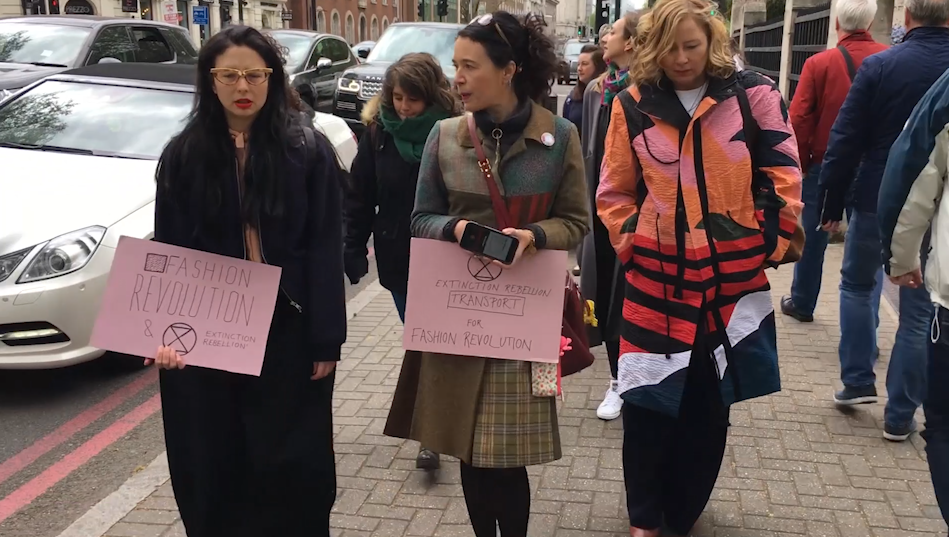
Here’s what was said:
Orsola de Castro: So the response to the protests… people are really prepared to put themselves out there. There were over 1000 arrests you say. Did you find that the overall response was positive?
SA: There has been criticism of the tactics used, there has been criticism of disruption, but that’s not we’re worried about. We want people to hear our demands, that’s what people should be focused on. I think we are making progress on that. Everyone is talking about climate change in a different way. Talking about it as an emergency. It doesn’t matter if they don’t agree with how we’ve gone about doing things. As long as it works.
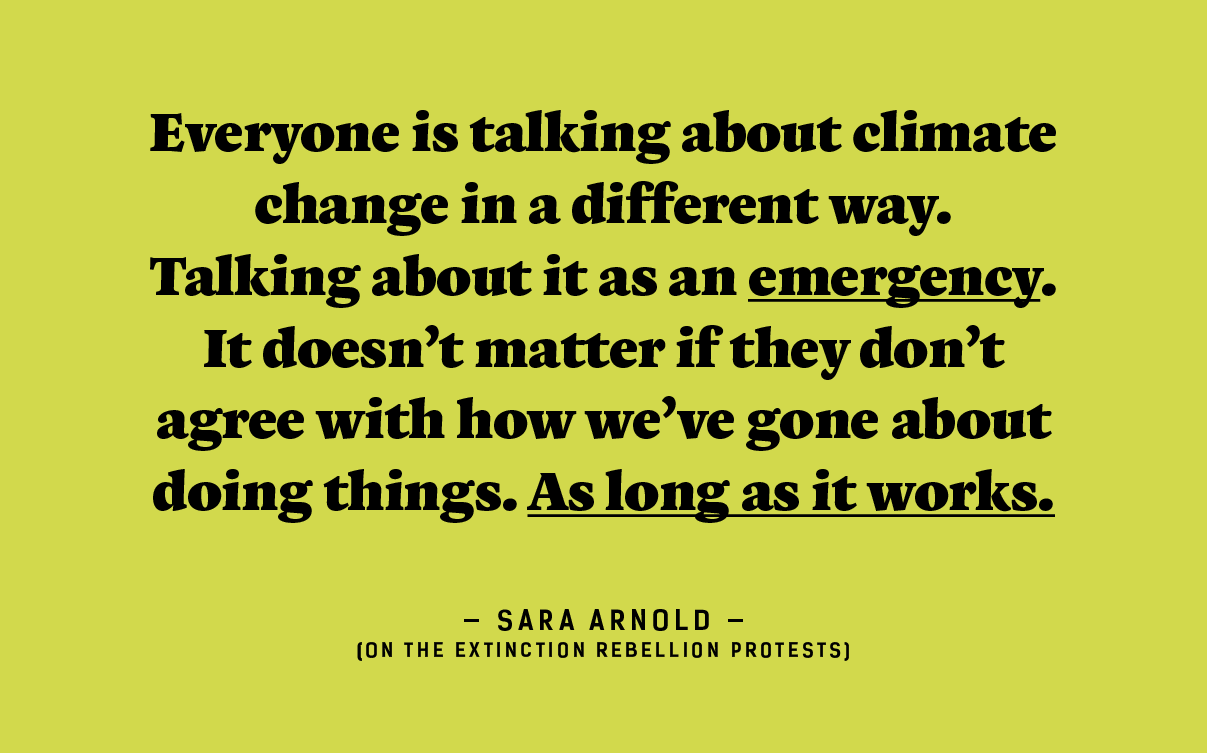
OdC: I’ve found that one of the reasons why we (Fashion Revolution) wanted to do this is the symbolism of joining hands. Even if everyone has a different way of doing things. The fact that the message is one of urgency is what we want to show. We need to all join together.
Could you tell me a little about how you guys started?
SA: Yes, so Extinction Rebellion were a group called Rising Up which started, in 2016, as a group of activists who wanted to theorise how they would go about creating this social change that we needed. They researched and put into practice different tactics. A member of Extinction Rebellion, Roger Hallam, who is currently doing his PhD at King’s College on these issues, one of the things he did was engage with an activist group at King’s that for years had been trying to get the University to disinvest from fossil fuel. They decided to stage a hunger strike. They were told that this process, even just the bureaucracy of disinvesting from fossil fuels would take a year to sort out. They said ‘okay, so let’s just try it’. So they went on hunger strike.
Sarah Mower: Because the university was investing in fossil fuels?
SA: Exactly. The whole process, from start to finish, from them going on hunger strike to all the investment coming out was 2 weeks. When they were told it would take years. So it just goes to show that direct action makes change. People do what they think is not possible when they are faced with disaster.
OdC: When I went to the first extinction rebellion meeting, you were talking about in war and in emergency, people make things happen. So the factories go from producing kitchenware to producing arms. When it is a state of emergency, historically, we’ve known citizens and organisations to take action pretty rapidly.
SA: Exactly. Now we have to get this declaration through to them so they can act.
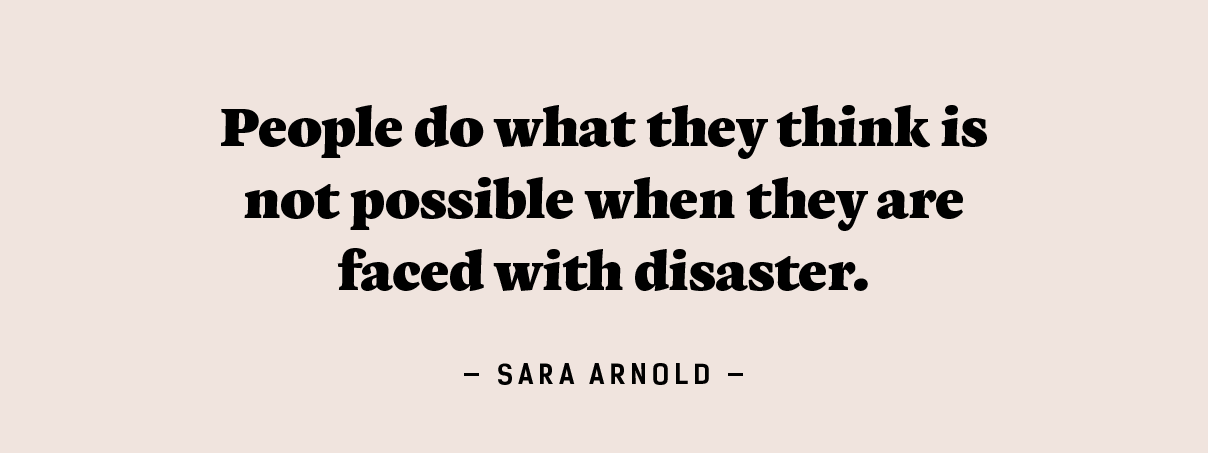
OdC: And so what about the involvement of Greta (Thunberg)?
SA: Greta was there when we held the Declaration of Rebellion on the 31st of October 2018. So we’ve had her support since the beginning. It’s really great that she came back at this time for the protests.
SM: She has changed everything.
OdC: She has changed everything.
OdC: You have other hubs in other countries, do you find there are other meaningful partnerships with local organisations in the rest of the world? Are you finding that people want to join you or do you find that they are hesitant to do so?
SA: The International Rebellion was in 33 countries. We have groups set up in 49 countries.
OdC: So like Fashion Revolution, you are de-centralised in the sense that it is volunteer run and people start their own groups.
SA: Yes. So we have 200 groups in the UK alone. The groups outside of the UK can have different demands to ours. They can adapt what we have done to respond to their own political situation. We’re so fortunate here to have police that are peaceful. And we have to use that privilege. We have a really engaged group in Ghana but if they did the same thing we are doing, they are looking at being arrested and then disappearing. It’s important for us to have solidarity with them. We keep a list of the names of those people so if anything does happen, we can protect them. It really interesting to get into that and see how we can help to take it further, internationally.
OdC: There are issues when you are a global group and you are dealing with law in different countries, even though the message is the same. Its important to recognise that.
OdC: How do you deal with citizens apathy out of fear? That people are so scared over what will happen, that they tend to go home and not know where to start.
SA: We need to really bring about this sense of urgency. That this is an absolute emergency. I feel its important to make people understand what the consequences are. We are talking about mass starvation, the death of billions of people if we reach a certain tipping point. Starvation is something we are really heading towards. We have 30 to 40 years left of fertile soil in this country, other countries are already hitting that. Let alone all the other problems. We are so dangerously close to hitting the tipping point.
Everyone is going to react to this differently. Everyone will go through a process of grief. And for a lot of people, grief will mean denial. That’s fine, you just have to feel compassion towards that. With extinction rebellion, what we are saying, is that when you give people the truth, a certain percent of the population, we think between 1 and 3% will rise up. And that is all we are aiming for. We need that 1 to 3% to rise up, to bring this to the governments and to take control.
OdC: And speak truth to power.
SA: Yes. We’ve been trying for the last 30 years to give people this positive message that we hope people will engage with and that great, but we don’t have time for that now.
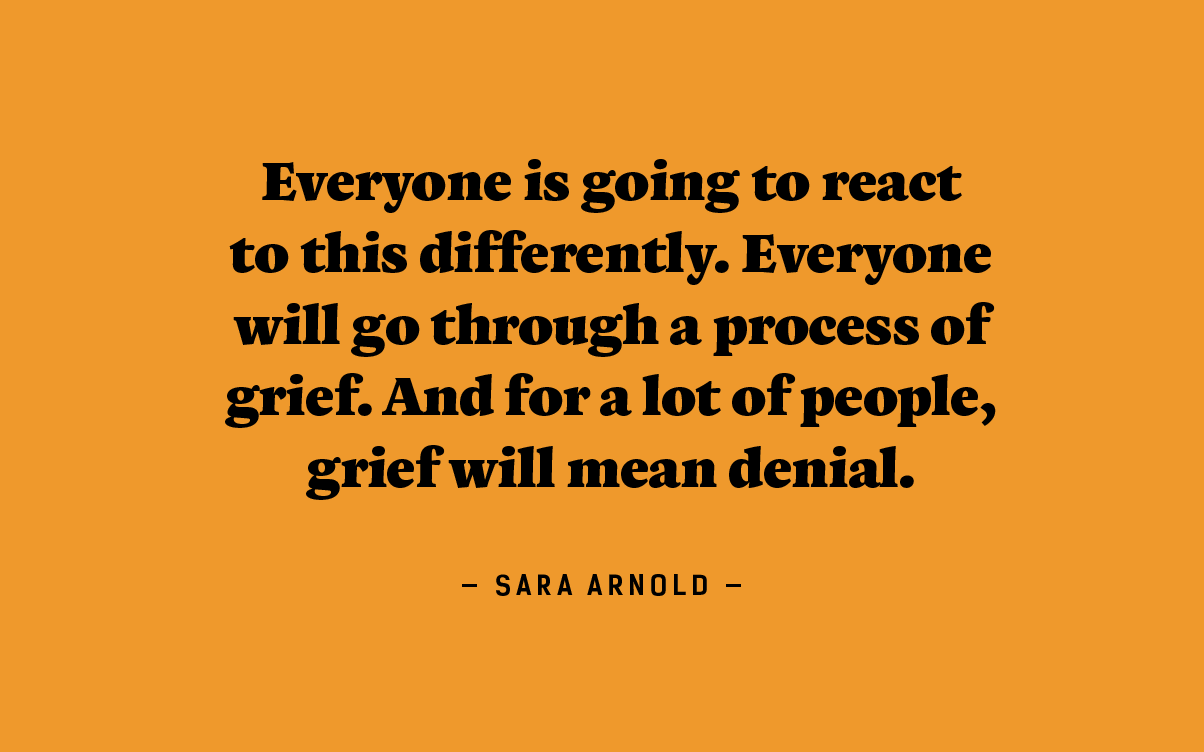
SM: So what do you think when Greta Thunberg stands in front of Michael Gove and he acts all Mea culpa. How do we hold him to account and get through real change?
SA: It’s a difficult question.
SM: If we’re talking about footfalls and governmental change.
SA: This is stage 1 of the rebellion. We can rise up and be bigger next time if we need to. I think. As we are doing that, we are waking people up to this emergency and its not something you can turn the clock back on. I think sooner or later the government will have to act.
OdC: I thought Mary Creagh was very honest at the recent Fashion Question Time when she was saying that we cannot do 2025 but working towards 2050, hoping it will gradually get faster and easier.
‘We aren’t going to get to net zero by 2025. The science will tell us what to do to get to net zero by 2050, and then in five years’ time to 2040 and then we’ll aim to get there for 2035. We have wasted the last 10 years, we’ve had no new policy in this country to change behaviour and we’ve done some policy mistakes along the way.’ Mary Creagh, Fashion Question Time at the V&A
SA: I think that we have to hit 2025. The Arctic is melting. We could lose it in a few years. That could be the tipping point that takes us into oblivion. We have to set our targets at something that seems impossible because then we are forced to look at system change. It is not about what we can do within the existing system, we have to look beyond that and listen to the science.
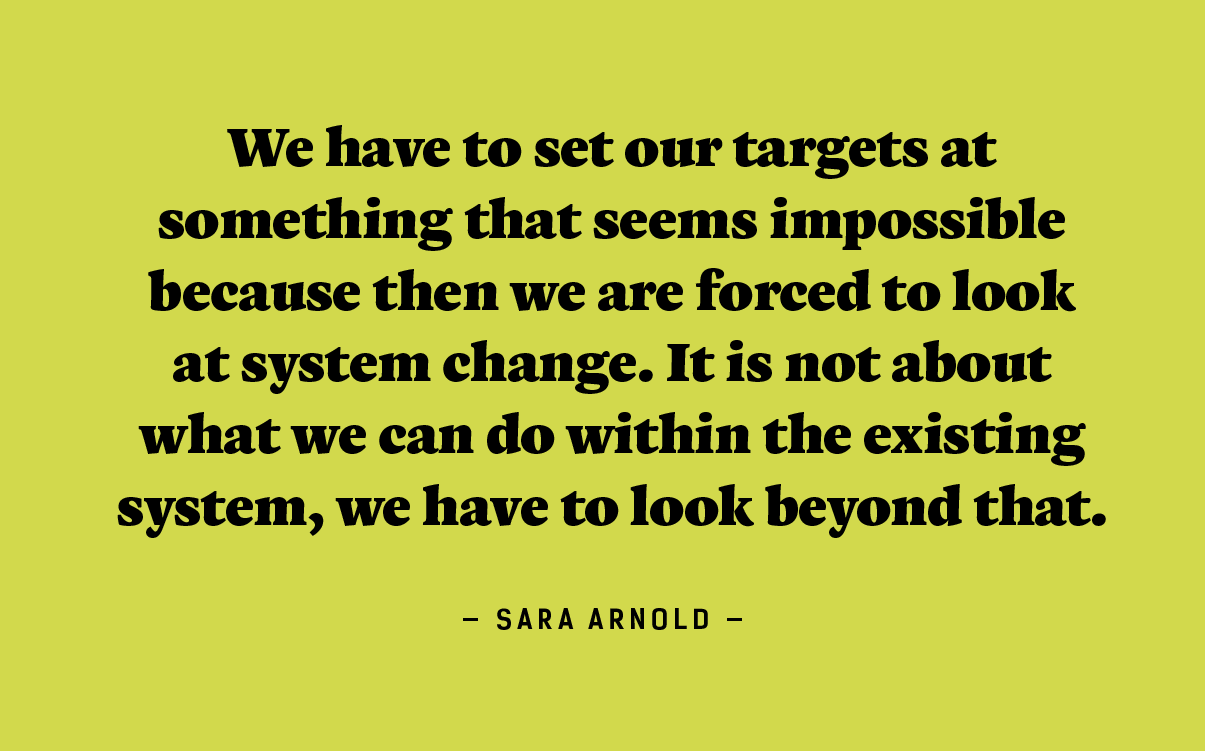
OdC: The science…the science corroborates that if we did stop now, it would get worse before it gets better.
SA: That’s the thing, pollution is currently cooling the earth. We are now 1.1 degrees warmer than we were during pre-industrial times. We need to keep ourselves below 1.5 if we are to avoid the most catastrophic consequences. BUT..If we slam on the brakes right now, the pollution will clear, causing an abrupt rise in temperature. This increase has been predicted to be between 0.5 and 1.1 degrees and so we may well have already used the carbon budget associated with 1.5 degrees of global heating. And that also puts us dangerously close to tipping points that will lead us into a so called ‘hot-house earth pathway’ of runaway climate breakdown. Its predicted that we reach this tipping point at around 2 degrees of global heating. Prof. Jem Bendell released a paper, ‘Deep Adaptation’, that puts together all the science to conclude where it is we are headed. His conclusion is that the collapse of civilisation is soon and inevitable. That immense catastrophe is likely and extinction possible.
‘I have chosen to interpret the information as indicating inevitable collapse, probable catastrophe and possible extinction.’ – Prof. Jem Bendell, Deep Adaptation: A Map for Navigating Climate Tragedy
So that is why we have to think about how we are going to adapt our culture, how we can reconnect with the thought of what it means to have a fulfilled life. What is important to us? This is why we say it’s not really about providing hope to people its saying we just need the courage to get through this and do what is necessary.
OdC: If we look at precedence, historically, the last time there was a massive mobilisation was in the 60’s. I often joke that the peace sign embroidered on jeans practically stopped the Vietnam war but it essentially sparked consumerism.
SM: Its true and now that generation, who are now grandparents, see their grandchildren protesting against it. It’s something I find very moving.
Further reading:
BBC: UK Parliament declares climate change emergency
Fashion Revolution Blog: Fashion Question Time at the V&A
The Guardian: Human society under urgent threat from loss of Earth’s natural life
Open Democracy: Britain just declared a climate emergency. What happens next?
IPCC: Special Report: Global Warming of 1.5 ºC
Life Worth: Deep Adaptation: A Map for Navigating Climate Tragedy
The Library: Study Hall: London Central Saint Martins
Check back every month for more in the Power of Influence series. We’ll post a new entry on the last day of each month throughout 2019. If you think there is someone we should be talking to, drop us a line on instagram.
We host Fashion Revolution Week in April of every year. This year kicked off on the 22nd of April. Throughout the week we encouraged people to ask brands ‘who made my clothes’ in hopes of shining a light on the unknowns of the fashion industry. By doing this, we hope to shift the focus from consumers to brands, and to all the hands involved, be it producers, workers, farmers or otherwise. We track the reach and impact of collaborators throughout Fashion Revolution Week and use the findings to fight for change worldwide, through government and policy. We are able to do this through the generous support of people like you. Please consider donating. Thank you.
Sparked by the buzz around HRH Meghan Markle choosing to shop amongst sustainable brands (yay), we found ourselves interested in learning more about the conscious and subconscious effect of social influencers and how that can shape our buying habits. Throughout 2019, we will be sharing our ‘Power of Influence’ series, talking to people within the fashion and social media realms about how they are using their platform for positive action. In this post, we celebrate Mutha.
Mutha are my favourite new source for all things sustainability. They not only have great fashion related content but they also delve in to other areas such as food, tech, sport and feminism. Their youtube channel is hosted by an insanely engaging team of presenters and their #relatable language and design aesthetic is something to be envious of. Current faves in their playlists include ‘Zero Waste Man‘ and ‘Black Friday Madness‘. To find out more about how it all happens, I chatted to Susan Adegboye, Mutha’s social media coordinator.
[youtube v=”6XqRPsULEnk”]
What is Mutha and how did it start?
So Mutha stemmed from wanting to celebrate the individuals and organisations operating in the world of food, fashion, travel and sport that are making a conscious effort to look after this planet of ours. We wanted to create a platform dedicated to the forward thinkers that were shifting the dial for a sustainable future, highlighting the importance of looking after the planet but without the scaremonger tactics.
Can you explain a little about the kind of content Mutha is creating to bridge that gap?
We tried to bridge that gap by including communities and groups that have previously never really been involved. A good example of this is SpAir Max Day, where we decided to tap into the sneaker community.
Coinciding with Nike Air Max Day on March 26th, we filmed a two-part series with renowned sneaker head Kish Kash, encouraging the sneaker community and a few household names such as Annie Mac, Clara Amfo and Leo Greenslade, to look into their vaults and donate some of their used, worn-in and probably landfill destined kicks to launch the first ever pop up sneaker shop where customers donate instead of buy. With the aim of collecting 1000 pairs of Air Max, cleaned by the team at Jason Markk and donated to the Brixton Soup Kitchen clothing and shoe bank.
We wanted to show the Mutha audience that upcycling and donating our used clothing and shoes not only has a positive impact on the environment, but that it can help people in our community in need. We wanted to work with the sneaker community to show how they can come together to do something good.
[youtube v=”ABaUzcJk33Q”]
I think thats a really interesting point – including communities that haven’t previously been part of the conversation. At this point, it feels like there is something everyone can do to play their part.
Exactly!
One of Muthas instagram post states ‘you don’t have to be perfect, just do your best’. Do you think there is a tendency to shame when it comes to issues of sustainability?
Nobody’s perfect and we all make mistakes, we’re human after all. It’s about what we do after the mistakes that really matters.
On that note, the team of presenters on Mutha feels very natural, honest, like they are part of the communities they interact with and they are experiencing the challenges and issues at the same time the audience are. Was it a conscious decision to work in this way?
Our presenters and the rest of the Mutha team, do not want to preach, but rather learn and share to inspire positive change. They represent the team behind the scenes who create the content and more importantly the audience who watch it. Our presenters come from varied backgrounds and have passions in totally different areas, but are all connected in the quest to learn and to live in a more sustainable way.
Thats definitely something that personally resonated with me when I first came across Mutha. It’s an inviting atmosphere. You sympathise and relate to the faces and voices you see and hear. Have you seen a positive reaction to this approach? Do your audience get it? Are they realising what they can do?
Ah we’re happy to hear that! At Mutha we believe that change has to start from within, we’re all on a journey here and in the 9 months since we started it we’ve all seen changes in ourselves and in our habits. The world of sustainability is often filled with doom and gloom, but a lot of us feel more optimistic now than we did before we started this journey. All the people that we’ve featured on our channel (and most of the feedback that we’ve received from our audience) is that Mutha feels like a celebration and inspires us to take the small actions that lead to big change.
So what does the future of Mutha look like?
The future of Mutha looks bigger and better, creating a lasting impact on an even wider scale. We hope that we can continue to provide a place where people can learn about sustainability and appreciating the world that we live in.
Thanks, Susan!
To keep up to date with all things Mutha, you can follow them on instagram and subscribe to their youtube channel. The second part of their two part SpAir Max Day initiative launched April 4th – see the video here.
Check back every month for more in the Power of Influence series. We’ll post a new entry on the last day of each month throughout 2019. If you think there is someone we should be talking to, drop us a line on instagram.
We host Fashion Revolution Week in April of every year. This year kicks off on the 22nd of April. Throughout the week we encourage people to ask brands ‘who made my clothes’ in hopes of shining a light on the unknowns of the fashion industry. By doing this, we hope to shift the focus from consumers to brands, and to all the hands involved, be it producers, workers, farmers or otherwise. We track the reach and impact of collaborators throughout Fashion Revolution Week and use the findings to fight for change worldwide, through government and policy. We would hugely appreciate it if you would be willing to share a story or celebrate a brand you love or simply ask #whomademyclothes during Fashion Revolution Week in 2019.
Sparked by the buzz around HRH Megan Markle choosing to shop amongst sustainable brands (yay), we found ourselves interested in learning more about the conscious and subconscious effect of social influencers and how that can shape our buying habits. Throughout 2019, we will be sharing our ‘Power of Influence’ series, talking to people within the fashion and social media realms about how they are using their platform for positive action. In this post, we talk to Ashley AKA bestdressed.
There is something different about Ashley’s videos. There is no big agenda, no preaching or bragging, no shaming when she talks about clothes. There is just this subtle little undercurrent of care and attention in the way she approaches her wardrobe. Thrifting, flipping (making new things out of old things) and the occasional scattering of self-deprecating humour makes for some exceedingly entertaining videos. Being an avid fixer and flipper myself, I wondered what made Ashley start working in this way and what effect, if any, she thinks it has on her audience.
Could you share your name and various media handles:
Ashley (aka bestdressed)
Youtube: bestdressed
Instagram: @best.dressed
Upon first glance, your youtube channel might seem like many others – OOTDs, clothing hauls and ‘day in the life of’s. When digging in though, your approach to sustainability through thrifting, upcycling and flipping your finds is totally ingrained into everything you do and say. For us, this is such an important and positive message to be spreading, something that others on the platform can seem to ignore. What made you start working in this way? Was sustainable fashion something you’ve always been conscious of?
I’m flattered, but honestly I never made a conscious choice to be a ~hero~ of sustainability! My love of thrifting and tendency to rewear clothes really comes from a financial perspective. When I was a younger, I never liked thrifting, My sister would always find gems, but I’d get bored and frustrated 15 ugly sweaters in and go play Doodle Jump in a corner. But two summers ago, when was in full on chipmunk mode post-wisdom teeth removal, I needed something to pass the time before my cheeks deflated. Lo and behold, I decided to go thrifting, and finally found some cool stuff. From that point on, I was obsessed – mostly because at that point I was still working for $8 an hour at an ice cream shop and could use the cheapest clothes I could get. Plus, I was about a year into my (vastly unsuccessful at that point) YouTube career. I would post a haul or OOTW here and there, but I could never seem to keep up with other girls who would have five completely new outfits each week. Thrifting, for me, was a way to experiment with my style and make interesting content, and rewearing clothes for years (even “fast fashion” clothes from Forever21) was just a product of not having that much money.
In a lot of your videos you alter, adjust, flip your existing clothes (or second hand clothes) into something totally new. Do you think it’s something everyone could and should be doing? Does this satisfy the itch to own something new, without playing into the fast-fashion world?
For me, it’s even better! It’s like Marx’s theory of alienation from the work product, right? There’s something so satisfying about making or altering something yourself. Every time you look at it or wear it you get to be like “Damn! I did that! And nobody else has anything like it!” I know everyone’s not the craftiest or has time to alter their clothes, but I hope I can encourage people to at least give it a try! Something as simple as patching up a hole instead of throwing a shirt out, or cropping an old t-shirt are a great place to start!
Do you feel the pressure from brands to buy? Do you think it’s possible to stay fashionable without buying in excess?
Absolutely. That’s the whole job of the marketing industry. And now social media is overtaken by the marketing industry. So every day, tons of images and videos are telling you that you want new things. Honestly I fall victim to this too. It’s usually only when I’m bored or procrastinating or feeling shitty, but I’ll go into this fervor of opening tabs and adding items to my cart. Normally the total price at checkout stops me though, haha. I don’t go to malls anymore because they make me crazy. Literally my brain just goes: clothes! clothes! more clothes! I sound insane but I swear this probably happens to a lot of us. Luckily, a lot of what’s “fashionable,” at least for a certain segment of internet hipsters, is shifting towards thrifted and vintage clothes. I love that it’s cool now to wear an old oversize t-shirt or a vintage linen dress. Since my entire job revolves around fashion, I do still buy new clothes, but I always think about my purchases thoughtfully and try to mix in thrifted, vintage, sustainable, and altered clothes.
Do you see an uptake in responsibility from your followers when you share content that focuses on sustainable issues? Do their responses show that they’re thinking differently about what they buy and how they buy?
Honestly unfortunately I think it’s a bit of singing to the choir when it comes to sustainable vs. fast fashion. There are still crazy amounts of $300, $500, $5000 Wish/Zaful/Shein hauls online, with audiences willing to watch. I’m chillin over here in my corner of the internet with gals who already love thrifting. And who’s reading this article? Surely people who already care about sustainable fashion. Perhaps that’s just me being a bit of a pessimist. In the long run, I think sustainable content can change how people think, but it takes time. I hope that at least some people who have subscribed to my channel from a fashion video have found their way to a thrift haul, and after watching a couple, have tried thrifting on their own! And maybe my thrift flips makes fellow sewing nerds like me feel a little cooler lol.
Okay now for some quick ones…
- Current favourite piece in your closet?
A sherpa jacket I thrifted from the men’s section! So cozy and looks like it cost a fortune - Do you remember the first piece of clothing that you ever bought for yourself?
A gray American Eagle hoodie in 6th grade - Do you still have it?
I wore it nearly every day to school for 3 years (I was one of those kids) but we had to part ways after it was pretty much falling apart. - Do you know who made the clothes you are currently wearing?
My top is thrifted (so not sure who made it originally) and my jeans are Redone vintage Levi’s made in the US. - Top tip for others wishing to shop more responsibly?
Start with browsing a vintage or thrift store, finding a few quality sustainable pieces to invest in, looking through your own closet to find old gems you forgot you loved… or even remembering to return items you don’t end up loving – that’s a huge one! It’s so easy, you get your money back, and you don’t end up with clothing sitting in the back of your closet. You’d be amazed by how many people buy stuff and can’t be bothered to return it. I think sustainable culture can be a bit intimidating and make you feel guilty for your past purchases or if you aren’t perfectly sustainable at the start. It’s all about starting small – even if you just stop and think about one fast fashion purchase per month, that’s still awesome!
Thanks, Ashley 🙂
Check back every month for more in the Power of Influence series. We’ll post a new entry on the last day of each month throughout 2019. If you think there is someone we should be talking to, drop us a line on instagram.
We host Fashion Revolution Week in April of every year. This year kicks off on the 22nd of April. Throughout the week we encourage people to ask brands ‘who made my clothes’ in hopes of shining a light on the unknowns of the fashion industry. By doing this, we hope to shift the focus from consumers to brands, and to all the hands involved, be it producers, workers, farmers or otherwise. We track the reach and impact of collaborators throughout Fashion Revolution Week and use the findings to fight for change worldwide, through government and policy. We would hugely appreciate it if you would be willing to share a story or celebrate a brand you love or simply ask #whomademyclothes during Fashion Revolution Week in 2019.
Sparked by the buzz around HRH Megan Markle choosing to shop amongst sustainable brands (yay), we found ourselves interested in learning more about the conscious and subconscious effect of social influencers and how that can shape our buying habits. Throughout 2019, we will be sharing our ‘Power of Influence’ series, talking to people within the fashion and social media realms about how they are using their platform for positive action. First up is Arden Rose.
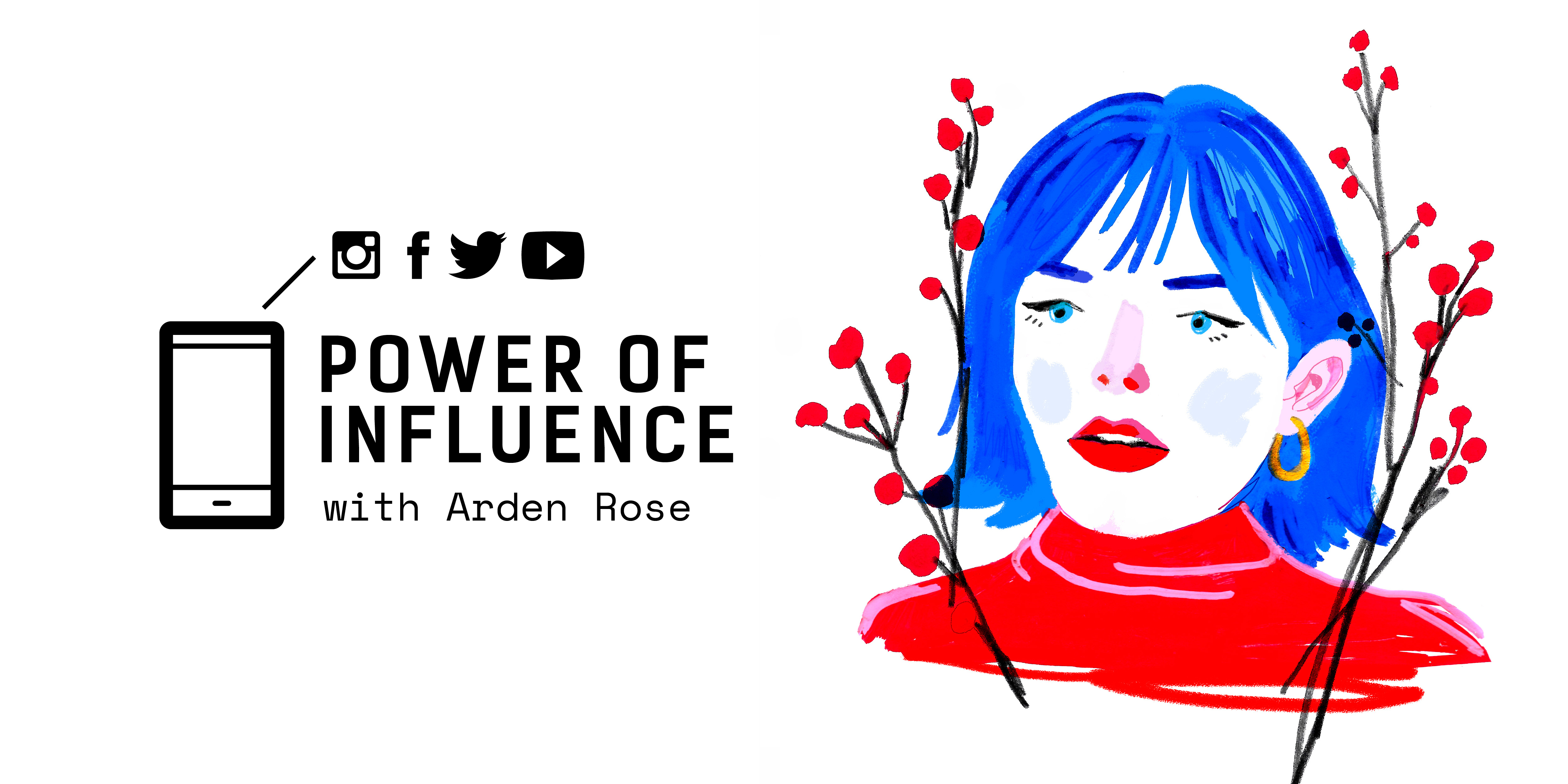
I was recommended Arden’s youtube channel by Youtube itself (thanks algorithms). Finding a funny, interesting AND socially, environmentally conscious human who also creates entertaining content is pretty rare, right? Exactly. I was hooked right away, and with 1.4 million youtube subscribers and coming up to 900k followers on instagram, I wasn’t the only one. My first point of call was watching the fantastically titled ”how to NOT destroy the planet while shopping“. There were many questions I wanted to ask, much admiration I wanted to share. So…after a quick binge of other videos, and a swift click of the subscribe button, Arden became the first in this series of interviews. Her answers didn’t disappoint. Read on, read on…
To start, could you share your name and various media handles:
@ardenrose on everything!!
In a community of hauls, where buying in excess and presenting that image to the world is commonplace, you choose to do differently. We think that’s totally awesome and also pretty brave. Was it hard for you to step away from the established way of working and suggest a different way of doing things?
It was hard in the sense that hauls tend to do well on YouTube and they’re easy (i.e. unoriginal) content to make. Honestly, buying that much junk was tiring, it filled up my closet with trendy pieces I don’t want in a month, and it was boring to make. I’m so much happier to share clothing that I had to hunt or search for to make it sustainable and worth showing on my channel! Honestly, everyone should give themselves the challenge of not relying on constantly selling their audience on cheap slave labor. Definitely helps me sleep (slightly) better at night.
Your video ‘how to NOT destroy the planet while shopping’ is SO well informed and honest and great. You mention other youtubers who inspired your choices. Do you think more people on the platform need to be addressing these issues?
ABSOLUTELY. It shocks me that people can just turn a blind eye to the obvious pain they allow corporations to get away with or ignorantly support. Everyone should be promoting sustainable business practices, especially the women on the internet that tend to to push fast fashion as a “cheap” and “easy” alternative to a constantly refreshing industry like the fashion industry. Viewers should be educated, but at the very least the entertainers who are preaching to them should be educated.
Have you always been a conscious consumer or was there a moment when the switch flipped and you started to think more about the way you buy?
I touch on this briefly in my “how to NOT destroy the planet while shopping” video, but I used to make H&M and Forever21 hauls allllll the time. Constantly. My channel was filled with that shit. Fortunately I sat down and watched all the necessary documentaries and read all of the articles late last year and completely got my stupid self educated on the issue. Honestly, I always KNEW that fast fashion was bad business, but I was wilfully ignorant so that I didn’t have to give up my shopping addiction that felt baked into my personality.
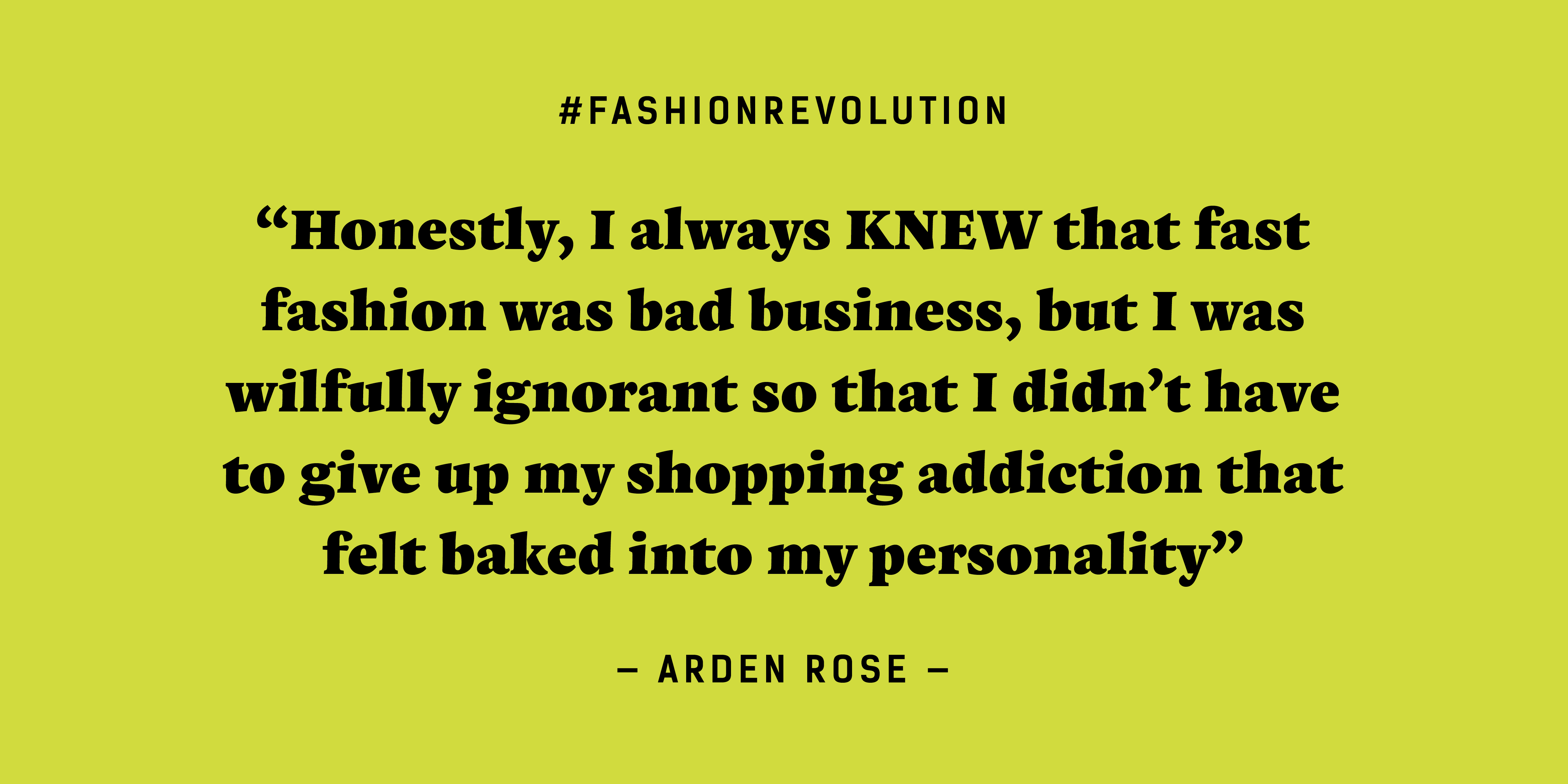
Do you see an uptake in responsibility from your followers when you share content that focuses on sustainable issues? Do their responses show that they’re thinking differently about what they buy and how they buy?
Yes!! And that’s what’s so amazing to me! I don’t even have the largest audience but I get hundreds of comments about my sustainability video a week. I didn’t even think that many people saw it! Nowadays, consumers want to be in the know, and they want clear consciences. Having a friend on the internet (me!) sitting you down and calling you out on the way you’ve been spending your money is helpful and doesn’t feel accusatory! It feels like friendly advice which is important. A lot of people get turned off of the sustainability conversation because it sounds preachy. You need to be a friend to these people, not a holier than thou asshole. I like to think I’ve helped a lot of young women and men rethink their spending habits when it comes to fashion, but I also think it’s just the power of a younger generation that actually cares about others and the planet! They’re awesome and so fired up for change!
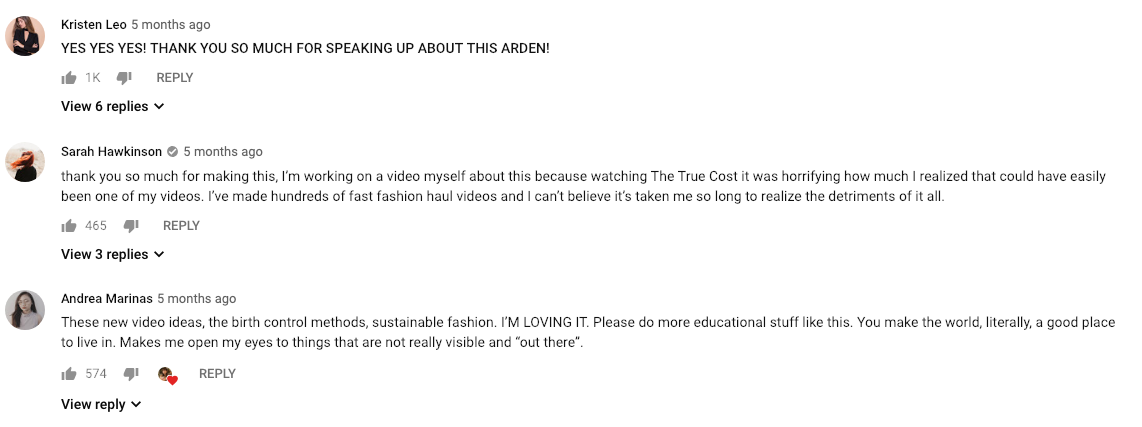
Do you think it is easy to find and share information about the sustainability of fashion brands and the effects of fast fashion on people and planet? Is there anything you can think of that would help make it easier to do so?
It is easy if you want to find it. It would be easier if large publications and fashion houses made it a priority to promote the message. It doesn’t benefit the industry to reveal its ugly underbelly, so they try to hide it, or dangle a carrot in your face via a “sustainable line” that only happens once in a blue moon. If there was a grassroots coalition of the top fashion bloggers and instagram baddies calling these companies out and only promoting sustainable brands, I can bet you big money things would shift in a major way.
Okay now for some quick ones…
- Current favourite piece in your closet?
A brown corduroy button down dress from Paloma Wool that I bought recently. - Do you remember the first piece of clothing that you ever bought for yourself?
I would have NO idea and I find that sad. It was probably a tee-shirt from Target if I’m being honest. - Do you still have it?
Definitely not. - Do you know who made the clothes you are currently wearing?
Yes! A small company in Denmark knitted my sweater, my tee shirt is of my own design and is produced sustainably in Canada, and my leggings are from an activewear company that produces everything in a mom and pop shop out of Italy. Wearing a very well traveled outfit right now hahaha. - Top tip for others wishing to shop more responsibly?
Unless a brand *explicitly* advertises that it’s sustainable, be skeptical, and even if they do, remain skeptical. Educate yourself. We have the internet now and have 0 excuses to be ignorant! If you question the sustainability of a brand, do a quick google search before committing to the purchase. It’s true that sustainable fashion tends to be a bit pricier but just think about all the hands that it took to create the piece you’re holding and the people they belong to that are being paid well and treated with respect because you’re willing to treat your closet with respect. We don’t NEED an abundance of new clothes every season, we’ve been duped by an industry that only has money in mind. You don’t have to have the latest trend in your closet, you can re-wear clothes until they fall off your body, and anyone who judges you for your lifestyle is slow on the uptake.
Thanks, Arden 🙂
Check back every month for more in the Power of Influence series. We’ll post a new entry on the last day of each month throughout 2019. If you think there is someone we should be talking to, drop us a line on instagram.
We host Fashion Revolution Week in April of every year. This year kicks off on the 22nd of April. Throughout the week we encourage people to ask brands ‘who made my clothes’ in hopes of shining a light on the unknowns of the fashion industry. By doing this, we hope to shift the focus from consumers to brands, and to all the hands involved, be it producers, workers, farmers or otherwise. We track the reach and impact of collaborators throughout Fashion Revolution Week and use the findings to fight for change worldwide, through government and policy. We would hugely appreciate it if you would be willing to share a story or celebrate a brand you love or simply ask #whomademyclothes during Fashion Revolution Week in 2019.
In it’s 5th year and already the worlds largest fashion activism movement, Fashion Revolution was formed in response to the Rana Plaza factory collapse in Bangladesh in 2013, where 1,138 people lost their lives. Calling for greater transparency in the supply chain, workers rights and a re-think of the way we use and consume clothing, Fashion Revolution is a global campaign that champions an ethical and sustainable fashion industry.
As Novel Beings, now A Novel Approach, Khandiz and I have worked with Fashion Revolution to art direct and produce their branding campaigns for 2015 and 2016, but we knew the 2018 should be something slightly different. Not only should the tone be reflective and respectful of the campaigns origins, but it should also celebrate all the wonderful young people who have embraced the rally all to action and joined the fashion Revolution.
So in order to celebrate all the wonderful revolutionary consumers who have joyfully taken up Fashion Revolution’s cause over the last 5 years, we ran a competition to find the faces of the 2018 Fashion Revolution campaign. We were looking for passionate young people, all at different stages of their own personal Fashion Revolution, to fly the flag for us.
We were overwhelmed by the response and delighted by our final selection. From musicians to bloggers and fashion students, please meet the Faces of The Revolution.

Grace Fairweather
How did you first hear about Fashion Revolution and what inspired you to want to be the next ‘face’ of the campaign?
I first heard of Fashion Revolution through the incredible London-based brand Birdsong. Dazed Digital did an article on them a few years ago and, even though I was already interested in and attempting slow fashion, this is when I really started to commit to ethical and sustainable living. A few Google searches later, I had found Fashion Revolution and the endless inspiration and information they provide.
When I saw Fashion Revolution was looking for “faces” for their anniversary campaign, I jumped at the opportunity to model for an organisation I align with morally. I’ve existed on the periphery of modelling for a while now; doing odd shoots and jobs for fashion-based businesses, but have always been wary of taking a job that could mean compromising my personal ethics. This is the first time I’ve modelled for an exclusively “ethical” organisation, (Fashion Revolution) and agency (A Novel Approach) and it was an incredible experience!
What do you do when you’re not posing for Fashion Revolution?
Hello! First-and-foremost an English student, but I’m also a blogger, model, and freelance writer.
What changes in your shopping or self-styling habits has Fashion Revolution inspired you to make?
One of the great things about Fashion Revolution is that, as an organisation, they champion multiplicity. My slow fashion journey has taught me that there is no one-way to live sustainably and any path you do take has its own complications, moral and otherwise. My current favourite to shop sustainably is Depop. I’ve recently created my own concept shop on there as an extension of my blog, November Meets May. (@novembermeetsmay on Depop).
Do you have any advice for anyone who would love to ‘green up’ their wardrobe and join Fashion Revolution, but doesn’t know where to start?
Equip yourself with knowledge! Knowledge will be your best tool in deciding which green path is right for you. Watch the True Cost, read newspaper articles on the current state and statistics of fast fashion, and keep up-to-date with Fashion Revolution. My own journey was a slow one and you don’t have to do anything earth-shattering to be a part of the revolution. Making the decision not to shop fast fashion for 3 months, a month, even a week is a great start and will make more difference to your life and the lives of others than you realise.
What is your most cherished piece of clothing and why?
I have the most incredible vegan, pinatex (pineapple leather) jacket from a sustainable, LA-based brand called Pangean, with “Save the Planet” embellished on the back. It’s easily the piece I get the most comments and compliments on. Nothing makes me feel more badass.
What will you be doing for Fashion Revolution Week?
There are so many amazing events on this year that it’s hard to decide! Here in Exeter an ethical clothing store, Sancho’s Dress, is putting on a different event every day of the week, so I really am spoilt for choice. So far, I’m thinking of attending their “Meet the Makers” panel and sales event party, and then heading up to London for the Depop x Fashion Revolution event, as well as (hopefully) the Galdem x Fashion Revolution event.
Who is your style icon?
Janelle Monae and Willow Smith. Sorry, I couldn’t pick one!

Mao Miyakoshi
How did you first hear about Fashion Revolution and what inspired you want be the next ‘face’ of the campaign?
I heard about it for the first time in Japan a few years ago. I was so happy that we could have the opportunity to share more information of ethical fashion to Japanese people because ethical fashion is still isolated compared with the European market.
I arrived in London from Japan with a two year visa, I made a promise to myself that I will try things that I’m excited about, even if it feels impossible or makes me anxious because you never know what’s gonna happen.
When I saw the post for ‘Model Wanted’ for the Fashion Revolution campaign, I felt super excited and imagined how nice it would be if I’m in the shoot. But after 3 seconds, the doubt appeared. ” Don’t be silly, Mao. You don’t have anything. You are not as beautiful or have as nice a body as model; you’re short, not skinny. Of course it’s not for you. Model needs to be like model.” But I tried to change my mind, decided to give it a try, because nothing would change if I fail. I thought an Asian girl being in the shoot in Europe would be interesting, and seeing a model that’s short and non-skinny can encourage people who think they are not special. Also, at least I passed the applicant requirement that I am in UK and I could attend the shoot date, and I LOVE ethical fashion! Also, I wanted to have more connections with like-minded ethical people, so I’m so glad I applied!
What do you do when you’re not posing for Fashion Revolution?
I’m beginning my work as a fashion stylist. I have been building my portfolio and sending submissions to magazines. So far, my work has been accepted by two magazines, one in Germany and one in America! I would love to use my work to promote ethical fashion. I’m also a fashion assistant at the sustainable fashion brand COSSAC and in October I’ll be a MA Textile design student at Chelsea College of Art.
What changes in your shopping or self-styling habits has Fashion Revolution inspired you to make?
I haven’t bought new clothes that much in the last few years since I have been into ethical fashion. I have three older siblings, they and my mother give me lots of clothes and because I love fashion styling I’m always trying to figure out more ways to wear the clothes I have.
But Fashion Revolution has definitely given me more ethical shopping options and ideas for how to how we can treat our clothes nicely.
Do you have any advice for anyone who would love to ‘green up’ their wardrobe and join Fashion Revolution, but doesn’t know where to start?
I would suggest they choose the category that they are interested in the most, like clothes, accessories or lifestyle or cosmetics and then Google it. You can easily find nice opinions and articles from bloggers and you can pick some nice brands from them. But the important thing is not to get stressed and worried. Sometimes, people feel a duty to purchase sustainable products, even if they don’t like the design. The approach is not going to work in the end. The key is to enjoy yourself, and celebrate the ethical and environmental movement at your own speed.
What is your most cherished piece of clothing and why?
My checkered trousers are the no.1 useful piece in my wardrobe. It can transform any way I like, for a cool style, or pop style and always people asked me where I got them. I found them at flea market in Yoyogi Park in Tokyo and they cost only £3! Another favorite piece is the T-shirt that I wear in second picture. This was a surprise gift from a friend; the design is from my favorite illustrator Kazuo Hozumi. She remembers that I like his work and she bought it for me as soon as she saw it. Always receiving a gift makes me pleased, especially if it’s a surprise. It was double happiness.
What will you be doing for Fashion Revolution Week?
The brand I assist at COSSAC, will have a show room in the event ‘Ethical brands for Fashion Revolution’, so I will be there, but I’m also planning to attend several events as all event looks super interesting so it’s gonna be quite busy week for me.
I am planning to ask #whomademyclothes but haven’t decided on the brand yet, as soon I do I’ll share the photo on instagram.
Who is your style icon?
I don’t have a specific fashion icon. My mother was my first icon, but I am always inspired by the arts and all kinds of actresses, films and photography. My favorite films are Amèlie and Simple Simon. I like directors with a unique view of the world of like Jean Pierre Jeunet and Woody Allen.

Rachel Callender
How did you first hear about Fashion Revolution and what inspired you to want be the next ‘face’ of the campaign?
I was introduced to Fashion Revolution through a previous graduate from my university. Their work is very focused on sustainability and conscious design, actively questioning and challenging attitudes towards the waste the fashion industry produces throughout the design process.
Knowing that I wanted to learn more ways to be a sustainable and considerate designer myself, he sent me the link to Fashion Revolution and voila!
How has Fashion Revolution inspired your shopping or self-styling habits?
Before discovering the campaign I had recently stopped shopping high street brands and I certainly can’t afford to buy designer clothes with just my student loan! So charity, second hand and vintage shops were and are still my go to. What Fashion Revolution has taught me is the importance of considering the lifespan of your purchases. Now I am even questioning my charity buys and how they could be recycled at the end of their lives, depending on their fibre content.
What do you do when you’re not posing for Fashion Revolution?
I’m a Fashion Design: Menswear second-year student at Central Saint Martins.
Do you have any advice for anyone who would love to ‘green up’ their wardrobe and join Fashion Revolution, but doesn’t know where to start?
When buying ‘new’ items for your wardrobe, start at a second-hand shop! Try Mary’s Living and Giving stores, or ’boutique’ charity shops if you don’t want to work too hard to find something beautiful, as they offer a more curated selection of garments.
But I have personally found the best garments at the jumble sale style shops! You just have to be willing to look long and hard, but when you do you can snag yourself a bargain for your toil. Repairing loved garments, instead of throwing them away if they become damaged by darning and patching, can actually make them look even better and gives character to clothes. I personally love sashiko stitched patches to revive tired clothes.
What is your most cherished piece of clothing and why?
I have a ginormous sweatshirt I bought at Crisis in Finsbury Park, which I adore and barely ever take off. It’s a heavily faded shade of purple with a screen-printed illustration of a Vizsla dog on the front, which is also peeling and fading. It seems to have been a work sweatshirt for ‘Red Dog Films’. I don’t know why I’m so attached to it really; I think I just love the little Vizsla print!
Who is your style icon?
I honestly couldn’t say I haven’t had one of those for a while! Style influence, on the other hand, would be a combination of my mum and dad’s wardrobes.
What will you be doing for Fashion Revolution Week?
I will be making my own clothes! Sourcing fabrics and all components which will allow me to definitely answer the #whomademyclothes!
But a problem a lot of designers and makers have is that more fabric shops than I’d like to hold back information about their supply chain which makes it difficult to ultimately determine whether the fabrics were created in sustainable and ethical conditions. There definitely needs to be more transparency in fabric shops. The Cloth House in Soho is one of the better stores in London for transparency and product knowledge. And online you can find fantastic eco options at Offsetwarehouse.

Freya Joy
How did you first hear about Fashion Revolution and what inspired you to want to be the next ‘face’ of the campaign?
I have been following Fashion Revolution since I joined instagram. I’ve always really admired their work, It’s such an empowering movement and it’s so easy for you to join in, get your hands dirty and really feel like your contributing to something important; armed with nothing more than a spare five minutes and your smartphone. Having been applauding Fashion Revolution from a distance for so long, I leapt at the chance to be a part of the campaign. I’m so grateful to have had the opportunity to be involved in something that has influenced and inspired me so much.
How has Fashion Revolution inspired your shopping or self-styling habits?
I’m a charity shop addict. It can be so hit and miss and I love that, it kind of feels like modern day treasure hunting. There’s definitely a feeling of success I get when I find something I love in a charity shop that I don’t get in the same way when buying brand new clothes. I’d say that’s where everything I’ve learned from Fashion Revolution has affected me the most. Understanding where my clothes have come from and the impact their production has on the lives of the people who make them and on the environment has definitely given me a newfound sense of responsibility as a consumer that has really lit the fire under my existing charity shop enthusiasm!
What do you do when you’re not posing for Fashion Revolution?
I’m a Musician and I also work for Lush UK.
Do you have any advice for anyone who would love to ‘green up’ their wardrobe and join Fashion Revolution, but doesn’t know where to start?
My main piece of advice, or maybe reassurance would be that it’s much easier than you think. One of the facts that really stood out for me, from Fashion Revolution’s fanzine, “Loved Clothes Last”, is that by extending the life of your clothing by a further nine months, you can reduce the carbon, waste and water footprint by around 20-30% for each piece. With that in mind, learning simple tricks for how to care for different fabrics, or how to repair clothes instead of throwing them away when they show signs of wear and tear, become inspiring, revolutionary acts.
What is your most cherished piece of clothing and why?
That’s a very difficult decision to make! I have a lot of my mum’s and brother’s old clothes that I wear often and love mainly because they were theirs first. But it’s probably a vintage M&S blazer I acquired whilst volunteering in a charity shop in my hometown when I was fifteen. I still wear it a lot now, but back then I don’t think I left the house without it for about two years; I just completely fell in love with it. Working at the charity shop was probably the catalyst for how crazy I am about charity shopping now. So there is definitely an element of nostalgia and gratitude I feel towards that blazer, which would make it difficult for me to ever part with it!
Who is your style icon?
My style icon would have to be Nai Palm, lead singer of Hiatus Kaiyote. Much like her music, her style is wildly varied and inspired by a diverse range of cultures and influences. Not one to shy away from accessories, metallics and bold colours, she usually wears lots of ever-changing chunky, oversized jewellery.
In a beautiful interview she did a couple of years back for the Under The Skin project, she talks about how a lot of the jewellery she is drawn to comes from nomadic cultures, which, being an orphan who moved around a lot as a child, she identifies with. She also talks in the interview about how off the back of her aesthetic, people who aren’t familiar with her work often assume she is in a punk band, when in fact she is an R&B/Soul singer. I really admire how her style doesn’t conform to any particular ‘genre’, really it’s the amalgamation of everything that she somehow manages to make work together seamlessly, that in turn makes her look so authentic and enchanting. I think that’s a really unique and beautiful thing.
What will you be doing for Fashion Revolution Week?
I’ll definitely be asking some brands #whomademyclothes… It’s an important question to keep asking. And I’m planning to come to some of the London events.
__
Download our campaign images here and help spread the word about Fashion Revolution!
Fair Trade Fashion From India
Secret Projects is a social enterprise working to ensure that women in India receive a fair wage for their work in the textiles industry. It aims to empower women by providing them with access to the global market for their skills and the products that they make: the final link in the chain they previously lacked.
Secret Projects now works with over 300 makers in six different states in India, making clothing a homeware. The makers are the most integral part of the business, and you are in invited to come and meet some of them:
Meet Lissy, our quality control expert. A former quality controller for Fab India, Lissy works in our Bangalore Production Support Unit checking all our products before distribution to ensure they are of the highest quality. We asked Lissy some questions about her work with Secret Projects…
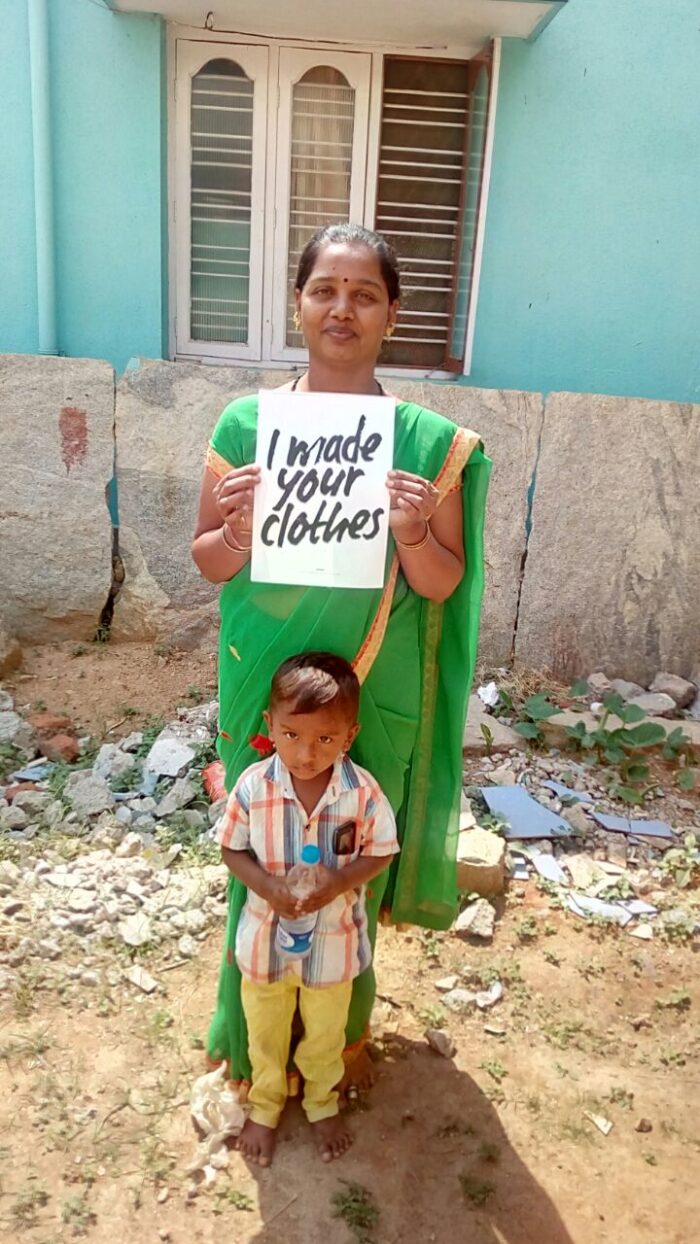
How did you become a quality checker?
I was working in the garment factory a helper for a year. My supervisor found me diligent and so asked me to take on the role of quality controller. I used to do the measurement and final quality check before products were sent out. This job requires following the entire cycle of the production. But I found the work in the factory very strenuous, and I could not manage it and my family at the same time, as I was never given leave. Then two years ago I came across Secret Projects, and I have been working here ever since.
What do you enjoy most about being part of the Secret Projects team?
I am able to work based on a timetable that is convenient for me. I am not in constant fear that I used to have in my previous jobs, as there is very good support.
What impact has being a quality checker with Secret Projects had on you and your family?
Personally, I am happy to be independent. I am able to manage my children’s school fees with the income. This has meant that I have retained my dignity, as I haven’t had to borrow money. I am no longer stressed, and I feel very happy.
How does it compare to other jobs you have had?
My previous jobs were always based on the management’s needs, whereas this job enables me to negotiate my timetable based on my own schedule.
Deepa is a member of our Bangalore Maker Network.
Deepa, how did you start sewing?
I have always had an interest in sewing, and my husband supported me to become a seamstress. I have been sewing for more than 10 years.
What impact has being a maker had on you and your family?
We were living in a very dilapidated house without much space at home. But through my income, we were able to save up and move into a bigger house that could also accommodate my sewing. This means a lot to me. I feel a sense of gratitude for what I have and am able to do. I hope in the future I can scale up my impact even more.
And what about your wider community?
I live in an urban settlement in Bengaluru. Members of my community often find themselves in distressing situations, and many of them are single mothers. There is a high suicide rate, as they often see no future for themselves. I can proudly say that I have been able to train many of them to sew, and they have found a new lease of life. Initially, when I train them, we support each other in the sewing and share the income. Once they are confident enough, they set up their own sewing unit at home, but it takes a long time to be able to save up to own a sewing machine.
I grew up in a small village. People there are very hard working but don’t have access to many job opportunities. I am keen to take Secret Projects to my village and share the opportunity that I have had with other community members. It would make me really happy to be able to do that.
How does it compare to other jobs you have had?
I used to feel hopeless and un-productive when I was staying at home and only doing household chores and staying at home. Now I feel that my life is so meaningful.
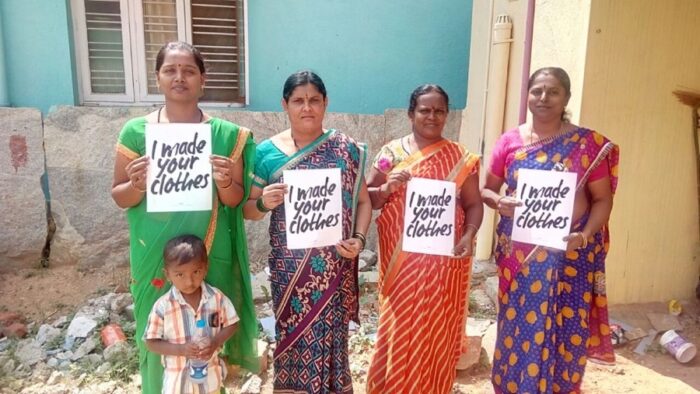
When Ubuntu Made first came to Maai Mahiu, we found a community of children with special needs and their mothers being mistreated and secluded. The stigma and lack of understanding surrounding special needs in Kenya means extremely limited access to essential services such as education, affordable healthcare, physical rehabilitation, and vocational training. This leads to limited opportunities for social inclusion, many social and economic issues for their families, and ultimately limits their ability to live the life of dignity that they deserve. Ubuntu first created the Ubuntu Special Needs Centre (SNC) to combat this stigma and injustice by providing therapy, education, and vocational training to youth with special needs in Maai Mahiu. Caring for these children had been a full-time job for their mothers, so soon after enrolling their children in the SNC their Mums started a new conversation with the founders: “Now that our kids are out of the house, can you help us do something productive with our time?”
The answer was a fashion line, initially imagined to create jobs for these Mums. Today, those same women have formed into a sisterhood revered in the community: women who provide for their families, purchase land, and venture into their own successful entrepreneurial efforts. Which is why it’s not simply about creating jobs.
“Plenty of people have been given opportunity, but they don’t feel empowered,” explains Zane Wilemon. “There’s something magical about our culture and creating a job within that; it then empowers the whole community.”
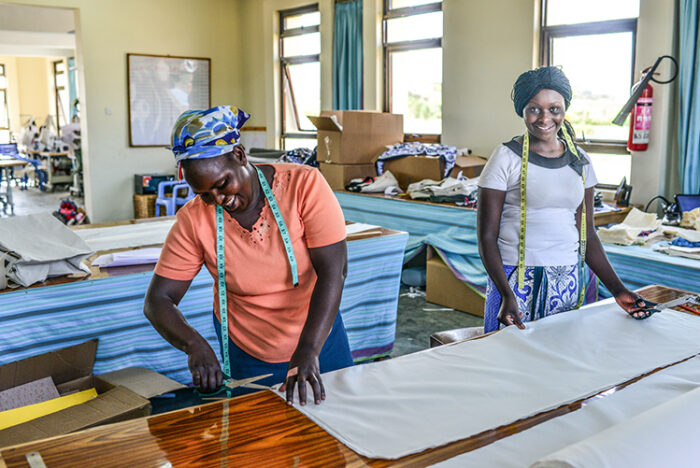
This conviction is what led Ubuntu Made to design and launch the Afridrille. At the intersection of customization and sustainability, the Afridrille merges customer experience with genuine connection. Based on the popular espadrille style shoe, their version marries modern on-demand manufacturing technology to an artisanal production process. Customers can choose from an incredible array of styles, choosing from a range of canvas colors, printed patterns, pattern colors, and African kanga linings. There are over 23,000 different design options, so each pair represents the personality of the individual customer. That means that each pair must be made to order, not produced in bulk in advance.
The key to making this process work is technology and expertise provided by Zazzle, a Silicon Valley company that makes customizing anything a possibility. They’ve applied their cutting-edge technology to enhance the customer design process and have dedicated hundreds of hours of senior staff time to help Ubuntu develop the new product, in a collaboration that re-defines what true “corporate social responsibility” represents today.
“At Zazzle we’re thrilled to extend our platform and technologies to Makers who craft products with soul, made from the heart. And there’s perhaps no better example of this than the Ubuntu Mums,” explains Jeff Beaver, Zazzle co-founder and Chief Product Officer. “Through our partnership with Ubuntu we’ve learned that providing economic opportunity is exponentially more impactful, and sustainable, than handouts or charity. These Afridrilles are more than just awesome shoes, they are a celebration of the human spirit, and every single pair empowers these Mums, their special needs kids, and their larger community. What’s better than that?”
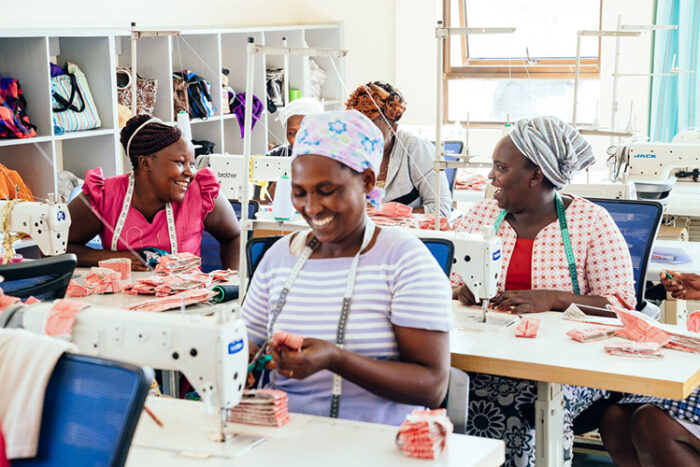
Crowdfunding the product launch via Kickstarter allows Ubuntu to build up production capabilities, expand the skillset of their ‘Maker Mums’, and perfect a complex operating process with the support of the Kickstarter community.
“Never underestimate the power of the entrepreneurial spirit and what can happen when people collaborate on something bigger than ourselves,” says Wilemon. “With the support of Zazzle and an eager crowdfunding audience, together we will scale up production and empower thousands of women and families in Kenya.”
At Ubuntu, empowerment means more than providing handouts or even a sustainable job. It means offering people a chance to create their own lives and livelihood. Ubuntu Made pays above-market wages to all of our employees – up to 4 times as much as they would have been able to find elsewhere in the community. We also provide health insurance to all our employees and their families, a rarity in Kenya where less than 20% have access.
The job skills our Mums learn and the money they earn empower them to buy homes – more than half of Ubuntu employees are homeowners compared to 1% nationwide. They are able to provide for their families, and sometimes start their own enterprises. They earn more than money; they earn respect in their community. Together, by providing disabled children with the healthcare and education they need, we empower them to realize their fullest potential.
That’s empowerment. That’s Ubuntu in action.
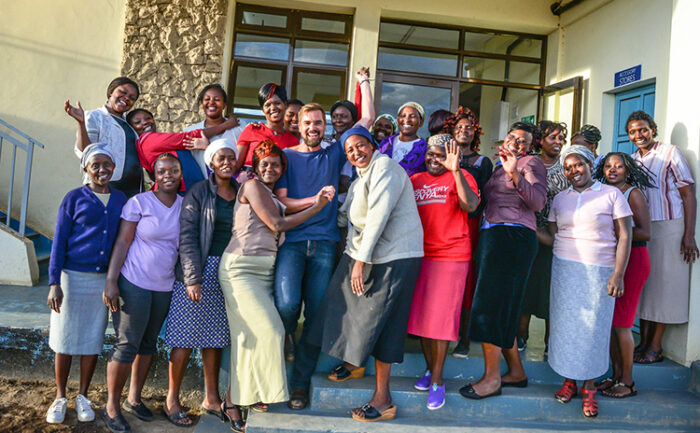
In her own words Nisha is honest, hard working and devoted. Nisha is a 28 year old mother of one. She is also a sewing machine operator at the Echotex manufacturing facility in Dhaka, Bangladesh. 6 months in into her role, the biggest challenge she’s faced is picking up the necessary skills to meet the quality standards required to produce the first NINETY PERCENT collection of premium basics. Every working morning, she says goodbye to her 5 year old son and leaves her home in Shafipur, Gazipur district to catch the rikshaw to Dhaka and make your clothes.
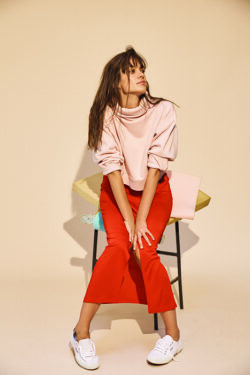
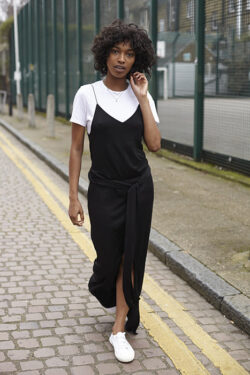
Greatest Achievement:
Being a kind mother to my five year old son is my greatest achievement. It’s hard to find the words to express my love for my boy but I feel heaven’s peace when he runs into my arms for a hug. It makes me so proud to see my tiny boy keep himself neat and tidy and behave well around friends and neighbours.
Work highlight so far:
Completing NINETY PERCENT collection 1 is my greatest career achievement. It was a big challenge for me to make sure the finish was first class. NINETY PERCENT is exclusive product so I had to work hard to assure the quality. I learned a lot making collection 1 and I hope these skills will serve me well in future.
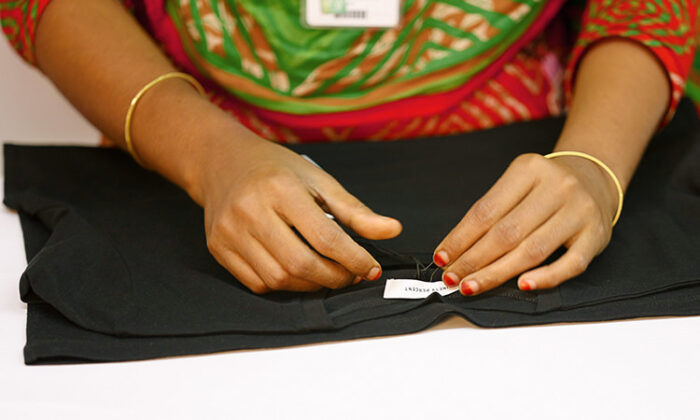
Best memory:
Catching fish as a child. I fished a pond near home in my native village of Bishnupur in the Gaibandha District. The best time to fish was late autumn when the water level was down and it was easier. All the boys and girls fished together then our mothers’ cooked the fresh fish for us.
Favorite place:
Cox’s Bazar – it’s the world’s largest natural sea beach. It’s an amazing feeling by the sea with the breeze and the sand. I’ve never seen any other beaches but I’m sure Cox’s Bazar is the best. Last winter the whole family went there, all the hotels and motels there are world class for all types of foreign and local tourists.
Best life advice?
My parents advised me to always be truthful. I’ve followed this advice at every stage of my life. Wherever I have been or done I have always been truthful. Actually, I think that’s my greatest achievement. It’s advice I passed on to my child – I think that’s why he is so well behaved.
The one thing you can’t live without?
My husband is my life partner – our marriage was arranged by our families. His name is Ashraful Alam and we’ve been living for 10 years. He feels my happiness and pain and tries to help me solve problems. We have a deep understanding of each other – our eyes can read each other’s hearts. My man is wonderful. He always takes care of me and shares what he thinks.
Where do you see yourself in 5 years?
In five years time I wish to be a team-leader. First of all I want to be the best most efficient employee I can – this will see me rise. My supervisor Mr. Azizul’s motivates me and boosts my self confidence. My first day in the job was a mixture of sadness, fear and happiness. I was sad because I thought I would be busy with no more free time to do what I wish. I felt fear because I didn’t know the job or the environment. I felt happy thinking about the money I would earn. Now I wake up in the early morning to complete my family tasks then say bye to my boy and leave for work. When I’m there, I complete my tasks, then return home at 5.30 pm to focus on my family again.
When are you happiest?
I become happiest outside of work when I’m with my family. We spend our time laughing, gossiping and doing lots of things. I love to play chess with my husband and cook – especially mutton curry. Before we go to sleep we always have cup of tea together at the end of the day. Making the tea for everyone is a special moment for me.
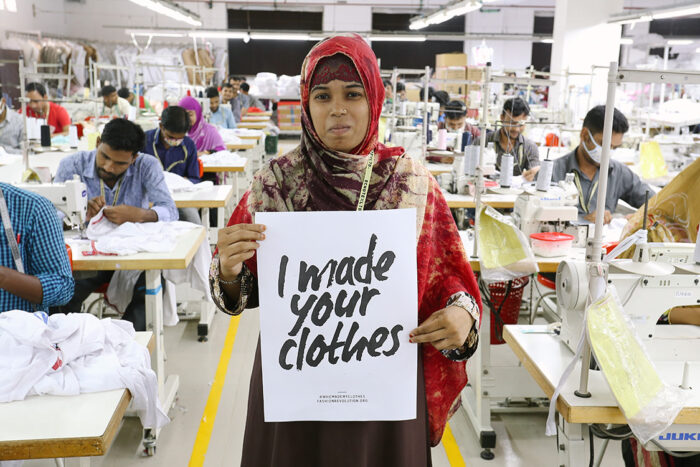
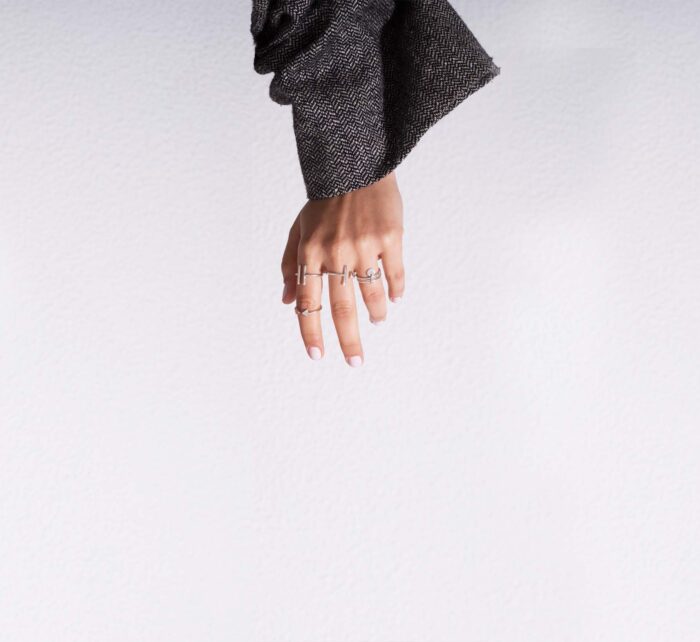
C’est en 2012, lors de son premier voyage en Inde que Rhita Benjelloun découvre la lithothérapie: approche holistique de soin, basée sur l’influence subtile, que peuvent apporter les minéraux sur le bien-être de la personne à son contact.
Passionnée de bijoux depuis son plus jeune âge et fascinée par la beauté, l’infini diversité des pierres et leurs pouvoirs énergétiques , elle créera à son retour sa marque rhita créations: des bijoux uniques, réalisés à la main, en argent 925 et sertis de pierres fines venant d’Inde.
Une manière pour elle d’allier la précision que lui impose son métier d’architecte au savoir faire du travail de l’argent de son pays d’origine, le Maroc. Chaque bijoux assemblé est unique et habillé d’une esthétique contemporaine et épurée, où la pierre est travaillée de la manière la plus respectueuse qu’il soit.
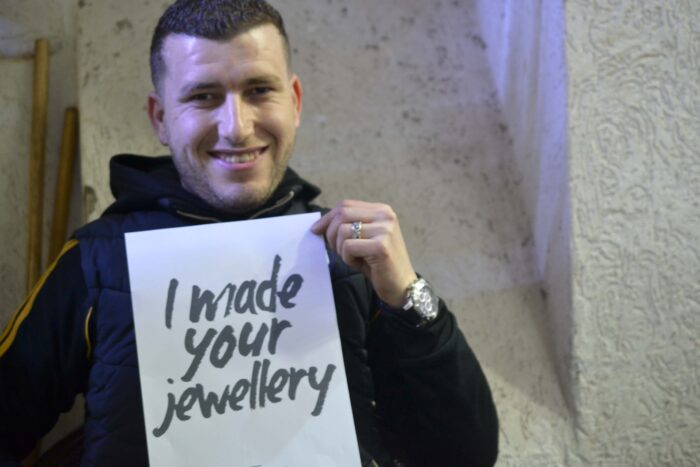
Simohammed
Simohammed a 33 ans, et est né à Fès au Maroc.
Chez rhita créations, il s’occupe de l’assemblage à la soudure, du sertissage et polissage. La soudure est ce qu’il préfère: c’est l’étape la plus délicate, car celle-ci doit être parfaite, fine et la plus discrète possible. C’est aussi la phase de la transformation et de la concrétisation du bijoux. Une phase décisive qu’il adore.
Ce qu’il aime le plus dans la vie: Le MAS (équipe de foot de la ville de Fès) et le FC Barcelone 🙂
Quand à moi ce qui me plait dans notre collaboration est d’abord son sourire d’enfant lorsque je lui donne à travailler des pièces compliquées, mais aussi son sérieux et son amour pour le travail bien fait.
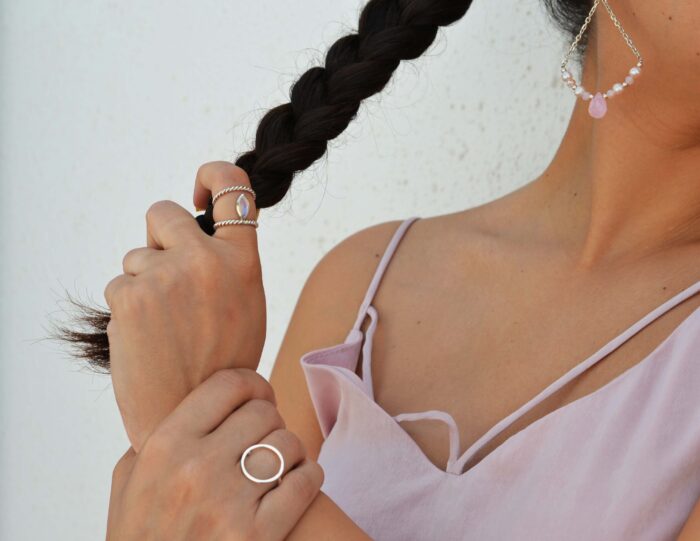
Facebook: rhita créations
Instagram: rhita.creations
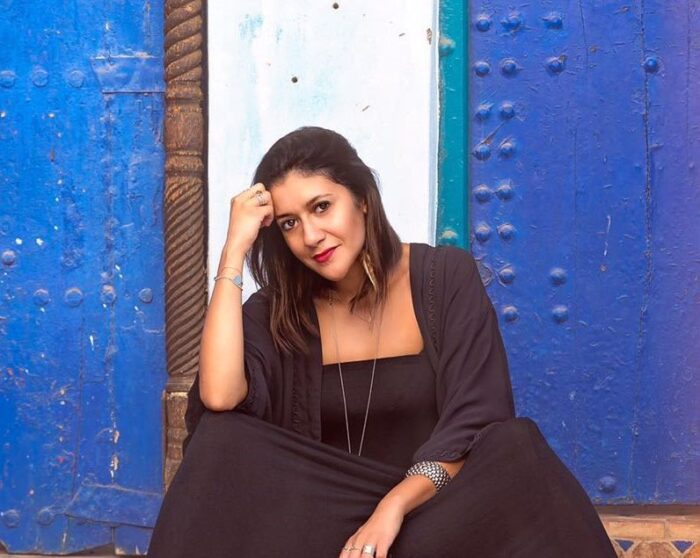
Fashion Open Studio 2018 – “the only fashion week worth caring about” – expands as a powerful platform for designers and brands to discuss who made your clothes during Fashion Revolution Week. Building on the initiative which started last year, designers from London to LA will be taking part, sharing their processes, ideas and best practice. This is a platform that celebrates transparency in the industry.
The aim of the week-long series of events is to engage the consumer further in the conversation about who makes our clothes – and to involve them in some of the processes along the way.
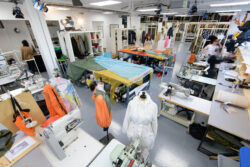
A diverse range of designers including Stella McCartney, Phoebe English, Christopher Raeburn, Community Clothing, John Alexander Skelton, Roberts|Wood, OneByMe, Katie Jones, Kepler London, Elvis & Kresse x Burberry Foundation, and Vivienne Westwood will each be adding their own voice to a Fashion Open Studio 2018, a week of talks, workshops, picnics and radical quilting.
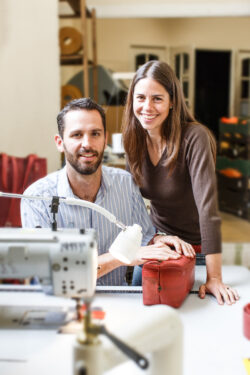
A highlight of the week will be the Burberry Foundation will be talking about their five-year partnership with Elvis & Kresse to re-engineer waste material through innovative craftsmanship in an open conversation at sustainable luxury visionaries Elvis & Kresse’s Kent HQ.
To kick off Fashion Open Studio 2018, Patrick Grant, founder of Community Clothing and CEO Lucy Clayton will be talking about why – and how – they are trying to revive the British manufacturing and textile industry. Their state of the art Cookson & Clegg factory in Blackburn now has the facility to produce 2,000 garments a month.
They will be joined by fellow industry veteran (ex Topshop, Asos and Finery London) Caren Downie, who recently launched her own Made in Britain glasses brand ByOcular. The opening event is supported by CELC – Master Of Linen, who will launch the I Love Linen campaign collaboration with Chelsea College.
MEET AND MAKE
Fashion Open Studio is a rare chance to meet and make with some of London’s most exciting young designers and their teams including Kepler London who will be opening up their Ridley Road studio to talk about how thy work and show some of their innovative knit pieces in production.
The designer cooperative Congregation who will be hosting a 3-day workshop to engage the public and create new work. They will be creating new pieces from the previously discarded. The pieces will be passed from designer to designer, each adding their own thoughts and expertise along the way and allowing them to develop into an unpredictable outcome.
All are finding new ways of producing their collections so they can take greater environmental and social responsibility for their fabric choices, supply chains and production processes.
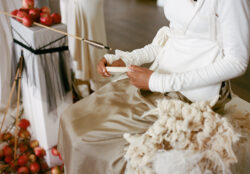
Fashion Open Studio is a great way to learn new skills from some of the industry’s most exciting talent. There will be a rare opportunity to join Phoebe English at her Deptford Creek studio in her Quilting From Waste workshop, using her waste fabric from the past year. She is looking forward to having time to join the stitching, to discuss waste, recycling, and how to combat mass consumption. The activist artist and poet Wilson Oryema will be on hand to read from his recently published book, Wait.
The acclaimed accessories designer Michelle Lowe-Holder will be hosting a ribbon reclaim jewellery making workshop.
And to end the week, one of the most innovative design duos, OneByMe will be hosting the launch of their ONELAB, a social enterprise which will encourage people to create their own garments like the OneByMe One Piece T-shirt. HOW WILL YOU MAKEIT will be an opportunity to try our hand at making your own piece of ONEBYME. This radical new brand is finding a new way of making fashion based around circularity. Any waste fabric is fed to their wormery. Cocktails using herbs grown from the resulting compost will be served.
In partnership with Sarabande: The Lee Alexander McQueen Foundation, there will be two talks. Fashion Open Studio curator Tamsin Blanchard will be discussing the merits of slow fashion with Sarabande designers John Alexander Skelton and Roberts|Wood.
DISRUPTING THE RETAIL INDUSTRY
Fashion Open Studio is excited to announce a partnership with the social online clothing marketplace Depop, to promote the Nothing New open studio event, focusing on why vintage classics are all you need. 40 % of 18-24 year-olds bought second hand clothing last year. Second hand clothing sites like Depop and The RealREal are changing the retail landscape, giving clothes a longer life and slowing the sale of new clothes. The Depop event at Protein Studios will be a chance to meet some of Depop’s own community of sellers and will feature an exhibition of iconic items and their story throughout the years. There will also be a workshop by the extraordinary footwear artist Helen Kirkum.
Remade Reduced Recycled is the Christopher Raeburn mantra. For Fashion Open Studio, Raeburn will be hosting Raeburn Repairs, an open day of free repairs. Guests will be welcome to bring along their favourite items that are in need of a little TLC to be repaired and remade as good as new (if not better). “In a world of overconsumption and fast fashion, one of the most radical thing we can do as consumers is to keep our clothes in use for as long as possible,” says Raeburn. We couldn’t agree more.
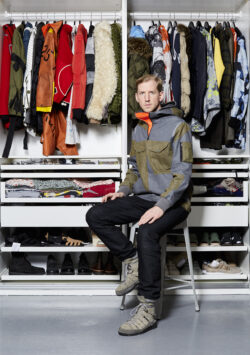
DO SOMETHING
Fashion Open Studio is a global event and will include workshops, talks and studio tours around the world. Highlights include:
Melbourne, A.BCH will be sharing the transparency story behind their basics brand, with Cutpiece, a series of up-cycling workshops. Participants are invited into the studio to make a new item from old clothing, off-cuts or salvaged materials. Participants will be able to choose their own adventure and skill level by choosing one of three workshops to be held throughout Fashion Revolution Week.
And in Shanghai, LVMH-shortlisted designer Xu Zhi will be opening up his Chinese studio with a rare opportunity to see some of his production techniques and craft.
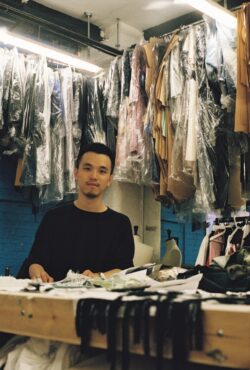
In Buenos Aires, Manto Abrigos will be hosting daily events at their showroom to talk about the stories behind their brand, the sociology of fashion, and the close connections with the artisans who make the clothes.
In Jakarta, Manual Jakarta presents Fashion Revolution Open Studio: Wilsen Willim, supported by British Council Indonesia and also Fashion Revolution Indonesia.
In New York and LA, Stella McCartney is celebrating her recent partnership with the consignment website The RealReal with in store events designed to inspire customers to care for, repair and prolong the life of their clothes so that they can have a second life as part of a circular economy.
Check out Fashion Revolution Open Studio events page for details of an event near you.
‘We want to celebrate the invisible process behind designers finished collections, the intimacy of a studio, the reality of the team, and see the people that make out clothes’ Orsola de Castro
‘This year’s Fashion Open Studio is such an exciting mix of creativity and new ideas. It is all about collaboration and making a different kind of fashion community. Open Studios is an opportunity to shine a light on a group of emerging designers – and some established trailblazers – who are finding alternative ways of producing fashion that is mindful of the makers, the planet, and its resources. They all work in very different ways and are at different stages in their journey but are united in their mission to make fashion better.’ Tamsin Blanchard, curator, Fashion Open Studio
Fashion Revolution Week, April 23-29 is a global campaign sparking a wider public conversation about the impacts of our clothes on the people who make them.
